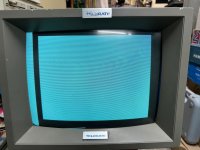RichCini
Veteran Member
All --
I have ongoing Lomas S-100 projects and one of them is getting Windows 1.04 running. The ColorMagic video board is CGA-compatible and generally runs anything I throw at it -- other than Windows. It would appear that the BIOS implementation is borked for the mode required (Mode 6, 640x200 B&W graphics). I ran the CGA Compatibility Tester and that passed (so the hardware is fine; bypasses the BIOS) but running a standard MS-DOS diagnostic (Check-It which uses INT10h) shows the same screen result as when trying to run Windows.
While searching, I came across this thread (CGA Composite Monochrome) which dealt more with fixing the look of monochrome characters on a composite monitor for a specific machine, but the issues are similar. So, my plan was to take the TSR template and see if I could create a BIOS replacement from it. I did search the Walnut Creek and SIMTEL archives for something already done, but there wasn't much there. If anyone has or knows of a utility that might work in this way, please let me know.
Thanks!
Rich
I have ongoing Lomas S-100 projects and one of them is getting Windows 1.04 running. The ColorMagic video board is CGA-compatible and generally runs anything I throw at it -- other than Windows. It would appear that the BIOS implementation is borked for the mode required (Mode 6, 640x200 B&W graphics). I ran the CGA Compatibility Tester and that passed (so the hardware is fine; bypasses the BIOS) but running a standard MS-DOS diagnostic (Check-It which uses INT10h) shows the same screen result as when trying to run Windows.
While searching, I came across this thread (CGA Composite Monochrome) which dealt more with fixing the look of monochrome characters on a composite monitor for a specific machine, but the issues are similar. So, my plan was to take the TSR template and see if I could create a BIOS replacement from it. I did search the Walnut Creek and SIMTEL archives for something already done, but there wasn't much there. If anyone has or knows of a utility that might work in this way, please let me know.
Thanks!
Rich

